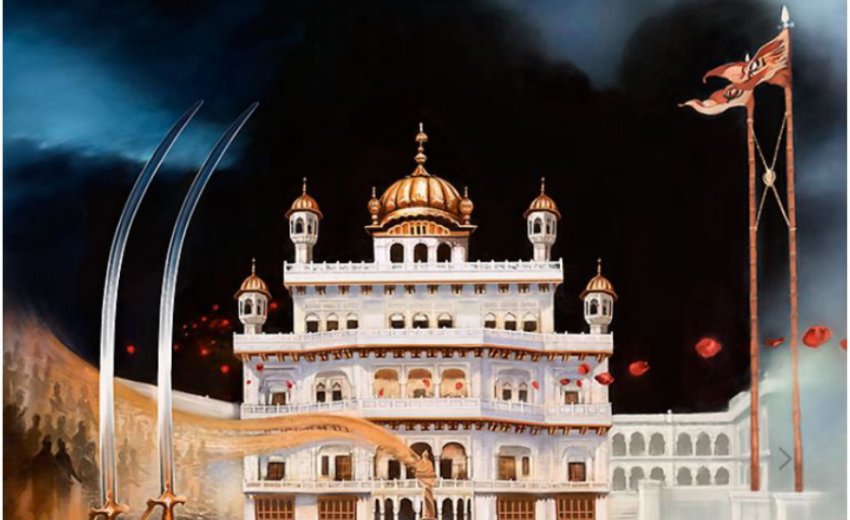The Story
Sri Akal Takhat Sahib Ji
This painting (created by Kanwar Singh of ArtOfPunjab) illustrates what Sri Akal Takhat sahib, the central legacy of Guru Hargobind sahib our sixth Guru, means to the Sikh quam. The artwork weaves the stories and imagery we relate to Guru Hargobind sahib, such as Bandhi Chhor and Miri Piri to capture the essential nature of our eternal bond to the Akal Takhat as central institution of Sikhism.
After the martyrdom of Guru Arjun dev ji, Guru Hargobind became the sixth Guru of the Sikhs at age eleven years old. He was imprisoned for several years by the Mughal emperor at Gwalior fort, but upon his release he insisted that 52 Rajas, who had also been falsely imprisoned, be freed alongside him. The emperor decreed that all the Rajas who could hold on to the Guru’s robe could follow him to freedom. Guru Hargobind Sahib secretly had a special robe sowed with many long tassels extending out, so that each the Rajas could hold onto him and thus follow him to freedom. Sikhs celebrate this event annually as Bandhi Chhor Diwas (prisoner release day) but the story also holds a deeper metaphor for our lives today. It is only by embracing our Guru, in the form of Siri Guru Granth sahib ji, that we can find a way out of the darkness which confines our spiritual selves. The Guru can become our Bandhi Chhor, bringing us from darkness to light, from ignorance to wisdom because when we clasp the hem of Guru sahib, we are bestowed the strength to liberate ourselves from oppression of mind, body and soul.
Guru Hargobind sahib, returned to Amritsar on the night of Diwali and Bandhi Chhor was joyously celebrated by the entire Sikh sangat as they had been separated from their Guru for three long years. Guru Hargobind then set upon building the Akal Takhat with his own hands, initially as a simple stone platform, from which he governed the political affairs of the Sikhs. He deliberately built the Akal Takhat higher than the Mughal throne in Delhi to assert the growing political sovereignty of the Sikh people, and accepted gifts of horses and arms to build the Sikh army. His grandson, Sri Guru Gobind Singh ji would solidify this spiritual and political union into the form of the Khalsa where Sikhs after receiving amrit, became sovereign unto themselves, dressing as kings to cast off the oppressors who sought to rule them body or mind. In the times that followed, tyrant after tyrant has unleashed destruction upon the Akal Takhat and Harimandir sahib because they are the most visible symbols of the spiritual and political revolution bestowed by the Gurus to strengthen the Sikhs.
Through the Akal Takhat, Guru Hargobind sahib permanently implanted the concept of Miri Piri, in that Sikhs had to be masters of both their spiritual and temporal selves. Guru sahib always wore two kirpans from the day he assumed the Guruship and thus the Akal Takhat always flies two Nishaans (Sikh flags) to emphasise this central doctrine. The natural insistence for self determination by Sikhs through Akal Takhat sahib has created the necessity for Sikhs to stand in defiance of invaders and tyrants from the time of Ahmed Shah Abdali to the modern day. Cohorts of Sikh martyrs from Bhai Mani Singh and Baba Deep Singh onwards have given their heads for the defence of the Akal Takhat and the Guru’s insistence upon self governance on all matters concerning the Sikh quam. The Akal Takhat stands to remind Sikhs of their duty to not only defend and uphold their faith but to assemble for Sarbat Khalsa and fight tyranny whenever it arises.
In this painting, the visualization of blood transforming into flower petals is a reminder that liberation can be found through sacrifice, when the cause is just. Countless shaheeds throughout our history teach us, that with the grace of the Guru and the willingness to bow ones heads in sacrifice, a transformation in the very depths of our being can be experienced. This perfect union of Miri Piri, the inseparable connection between Sri Harimandir Sahib and Sri Akal Takhat sahib is shown in the painting as two interwoven energies. Within their merger we see the khanda and the bata which represents the formation of the Khalsa panth and creation of a new type of being, the saint soldier.
To see this and other Sikh paintings by artist Kanwar Singh, please visit his online gallery.
Editor's Note: This article was originally published on Nov. 12th 2018







